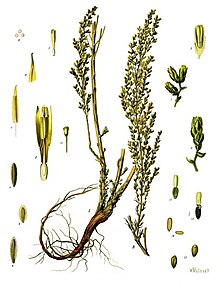Worm seeds
| Worm seeds | ||||||||||||
|---|---|---|---|---|---|---|---|---|---|---|---|---|

Worm seeds ( Artemisia cina ) |
||||||||||||
| Systematics | ||||||||||||
|
||||||||||||
| Scientific name | ||||||||||||
| Artemisia cina | ||||||||||||
| O mountain |
The wormseed ( Artemisia Cina ), also Zitwerbeifuß , Zitwerblüte , Zitwersamen or Wurmsaat called, is a species of the genus Artemisia within the family of Compositae (Asteraceae). It comes from the areas of the former Soviet Union and is used as medicinal and ornamental plants .
description

Vegetative characteristics
The worm seed is an annual to perennial herbaceous plant to subshrub that reaches a stature height of up to 60 centimeters.
Generative characteristics
In total inflorescences there are many cup-shaped partial inflorescences. The flower heads contain only a few green-brown flowers. There are achenes formed.
distribution
Artemisia cina is common in Russian and Asian steppe areas , particularly in Kazakhstan , Kyrgyzstan and the Chinese province of Xinjiang .
Taxonomy
The first description of Artemisia cina was made in 1863 by German botanist Otto Karl Berg in in cooperation with Carl Friedrich Schmidt created work illustration and description of all the officinal plants listed in the Pharmacopoeia Borussica ... , 4, panel 29 A synonym of Artemisia cina O.Berg is Seriphidium cinum ( Upper Mountain ) Polyakov . But the accepted name is Seriphidium cinum (O.Berg ex Poljakov) Poljakov
use
Most of the plant parts available on the market come from Kazakhstan .
Active ingredients
Several sesquiterpene lactones were isolated as active ingredients , which can account for up to 6.5% of the dry weight in the flowers . From this group of substances, α- and ϐ- santonin , as well as artemisin, were identified as the main ingredients of Artemisia cina .
use
The name worm seeds already suggests its use as a remedy against worms . Located in the flowers of Artemisia cina contained Santonin is an effective wormer that against tapeworms and other intestinal parasites such as pinworms and roundworms is used. The substances have a stimulating effect on the worms' muscles. In times when safe worming agents were not yet available, overdosing often resulted in poisoning . Therefore, if use should be necessary, the drug should only be applied in the form of finished preparations .
As a medicinal plant it is also called Zitwerblüte traded, but with the ginger family belonging Zedoary not related.
Symptoms
Induced by the active ingredient santonin, poisoning leads to unconsciousness and epileptic seizures. In the case of poisoning, a visual impairment occurs first , and the person affected is no longer able to see purple. This makes his surroundings appear yellowish to him (seeing yellow). This is followed by strong bile formation , jaundice and abdominal pain, as well as diarrhea, nausea and vomiting. Furthermore, feelings of cold occur and there is increased saliva and tears. The pupils are dilated, shortness of breath sets in and hematuria occurs due to the kidney damage that occurs. In addition, facial muscle spasms and paralysis in the legs occur, accompanied by a lowered body temperature, delirium and subsequent coma and death. The latter occurs through respiratory arrest . In addition to the symptoms described, hallucinations, drowsiness, and dizziness have also been described.
pharmacology
The main ingredients of Artemisia cina are neurotoxic , psychoactive and very toxic (Ib), especially the santonin. This is responsible for both the neurotoxic and hallucinogenic effects of Artemisia cina . Santonin acts on the brain and spinal cord and stimulates the motor centers. In the body, the substance is metabolized to hydroxysantonin . This substance causes the urine to turn yellow. An amount of approximately 10 grams of dried flower material is fatal to an adult human. The lethal dose of santonin is 15 mg / kg body weight. For a child, as little as 60-300 mg can be fatal, whereby the amount does not refer to one kilogram of body weight, but rather the total dose. The LD 50 for mice is 900 mg / kg for oral intake, 130 mg / kg for intraperitoneal administration and 180 mg / kg for intravenous administration.
First aid and clinical therapy
As an immediate measure, activated charcoal and sodium sulfate are administered . In addition, a lot of fluids should be supplied. In clinical therapy, gastric lavage , usually with 1% sodium permanganate , is carried out after the ingestion of larger amounts , as well as the application of activated charcoal, sodium sulfate and polyethylene glycol 400. Furthermore, electrolyte substitution and an acidosis treatment with sodium bicarbonate . The kidney function must also be checked and monitored. If cramps occur, diazepam or thiopental is administered . If colic occurs , atropine is administered and, in the event of severe symptoms of intoxication, intubation and artificial ventilation are required.
Common names
In the German-speaking area, the other trivial names Reinsaam ( Low German ), Sebersaat ( Rendsburger Apoteke), Welsamen ( Middle High German ), Welsonen, Wormkrud and Wormsaat (Low German) are or were used for this plant species, in some cases only regionally .
literature
- Michael Wink, Ben-Erik van Wyk, Coralie Wink: Handbook of poisonous and psychoactive plants. Wissenschaftliche Verlagsgesellschaft, Stuttgart 2008, ISBN 978-3-8047-2425-9 .
Individual evidence
- ^ A b Artemisia cina in the Germplasm Resources Information Network (GRIN), USDA , ARS , National Genetic Resources Program. National Germplasm Resources Laboratory, Beltsville, Maryland. Retrieved February 19, 2018.
- ^ Georg August Pritzel , Carl Jessen : The German folk names of plants. New contribution to the German linguistic treasure. Philipp Cohen, Hannover 1882, p. 43, online.